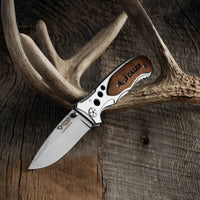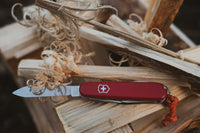Knife Maintenance: Everything You Should Know
Key Takeaways
- Maintaining a knife involves cleaning, sharpening, lubricating, and conditioning.
- Use water and dish soap for basic cleaning.
- Use isopropyl alcohol for deep cleaning.
- Use knife oil to lubricate moving parts and mineral oil for wooden handles.
Learning how to maintain a knife is an important rite of passage for new owners. After all, pocket knives are often deeply meaningful keepsakes, as well as useful everyday tools. You want your knife to provide a lifetime of enjoyment and functionality, and eventually become a family heirloom. Proper care is a must! Follow this guide to keep your knife in tip-top shape.
1. Get Familiar With Knife Maintenance Supplies
First, you’ll need the proper tools for the job. Many are ordinary household items you probably already own.
Cleaning:
- Dish Soap: Dish soap is gentle yet effective.
- Microfiber Cloth: You can use a normal washcloth, but a microfiber cloth will ensure your knife doesn’t get scratched.
- Q-Tips and Cotton Balls: These are handy for getting into hard-to-reach areas.
- Toothbrush: Don’t throw your old toothbrush away! It’s great for scrubbing.
- Isopropyl Alcohol: Rubbing alcohol makes easy work of stubborn residue and grime.
Sharpening:
Maintaining a sharp edge is a big part of regular knife maintenance that’s easy to forget about. There are a few different sharpening tools and techniques, so it may take some trial and error to find your go-to approach.
It’s important to note that manual pull-through sharpeners can and will damage blades. We highly recommend avoiding them. Here are better options:
- Whetstone: Learning to use a sharpening stone is a fun part of the hobby!
- Ceramic Rod: Honing the blade with a ceramic rod reduces how often you need to sharpen with a whetstone.
- Strop: A strop puts the finishing touches on the blade, ensuring that it has a razor-sharp edge.
Lubricating and Conditioning:
Lubricating the metal components and conditioning the wooden handle (if applicable) is an important part of knife maintenance. As you learn about how to maintain a knife, try only to use lubricants, oils, and conditioners that are formulated specifically for knives, or at least known to be safe.
- Knife Oil: Machine or gun oil will usually work, too.
- Wood Conditioner: Mineral oil is a popular choice.
2. Clean the Knife Regularly

Be proactive with cleaning. Over time, even microscopic bits of dirt, dust, and grime will add up, and it’ll be a lot more difficult to clean once it’s caked on.
Daily Cleaning:
Wiping down the knife and handle with a microfiber cloth is as easy as knife maintenance gets! A dry cloth works, but you may want to dampen it for a more effective cleaning. Dry the knife thoroughly when you’re done.
Deep Cleaning:
Whether you just prepped a meal with a camping knife, processed a catch with a fishing knife, or it’s finally time to de-gunk your everyday carry, sometimes your knife will need a thorough cleaning.
Disassembling the knife allows you to scrub everything thoroughly, but reassembling it can be challenging. If you decide to disassemble, take pictures before, during, and after so you have a cheat sheet when putting it back together.
Everyone has their own approach when it comes to knife maintenance. We recommend using a solution of warm water and a drop or two of dish soap. If the soapy water isn’t cutting it, use isopropyl alcohol.
Use a toothbrush to scrub the knife inside and out. Q-tips and cotton swabs can help you reach tight spots. Take your time, making sure to get in every nook and cranny. If you’re going to do it, do it right the first time!
Rinsing and Drying:
As you learn how to maintain a knife, make drying the knife when you’re done a top priority and a habit. Even a little bit of moisture can rust metal parts and damage wood. When knife maintenance goes wrong, improper drying is often the culprit.
After cleaning the knife, rinse it in clean water to remove any residual cleaning product. Next, you must completely dry every inch of the knife before moisture has time to set in.
If you disassembled the knife, use a clean towel to dry all components before putting it back together. If you didn’t disassemble the knife, dry it as much as you can with a clean towel, and then finish the job with compressed air, a powerful fan, or a hair dryer on the lowest setting (excessive heat can damage some materials).
Sharpen the Blade Every Few Months or More

Sharpening is optional knife maintenance, but we highly recommend it if you use your knife for utility tasks like cutting and slicing.
Use a whetstone for basic sharpening. Everyone has their preferred technique, so watch a few YouTube videos to get the basics down. After sharpening with a whetstone, you may want to do touch-ups with a ceramic rod and/or leather strop.
Oil Moving Parts Occasionally
Oiling moving parts is another big part of learning how to maintain a knife. Lubricating the pivot point and locking mechanism(s) will keep the blade opening and closing smoothly and easily, especially if it’s an assisted-opening knife. Here’s how to perform this knife maintenance:
- Apply a few drops to the pivot point and locking mechanism.
- Open and close the blade and use the lock a few times to work the oil into the crevices.
- Use a clean, dry cloth to remove excess oil.
Condition the Wooden Handle Once in a While
Finally, if your knife has a wooden handle, apply mineral oil or your preferred wood treatment to prevent the wood from drying out or absorbing moisture. Simply apply it to a clean cloth, work it into the wood, and wipe away excess conditioner.
Customize a Pocket Knife
We hope this guide to knife maintenance is helpful! While you’re here, consider personalizing one of our high-quality pocket knives for yourself or a loved one. We carry the top brands, including Bear & Son Cutlery, Victorinox Swiss Army, Case, Kershaw, and more. Shop now!







